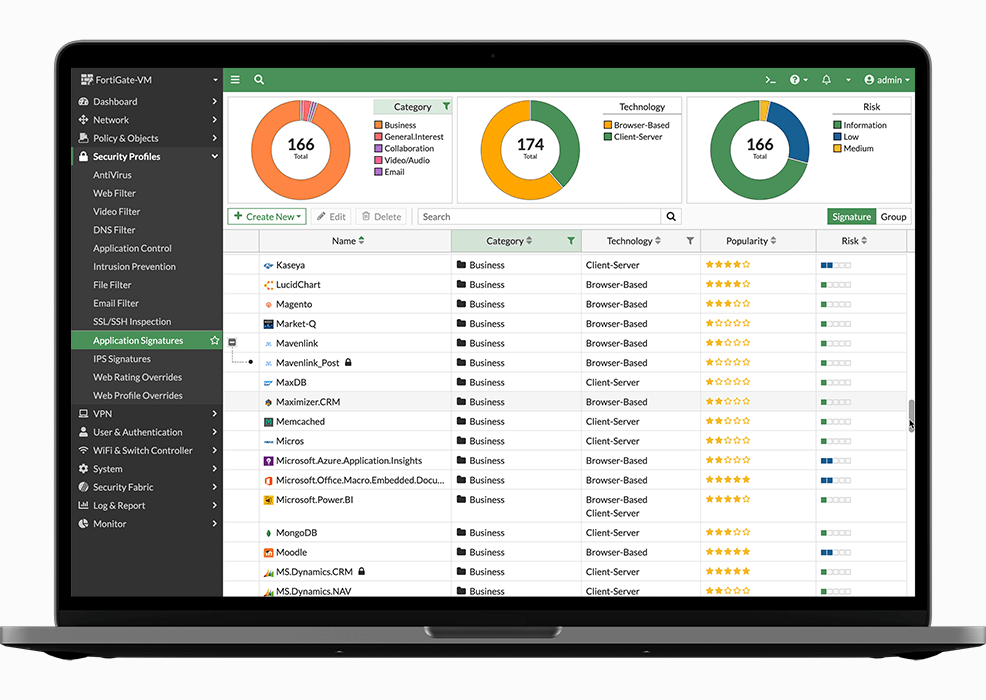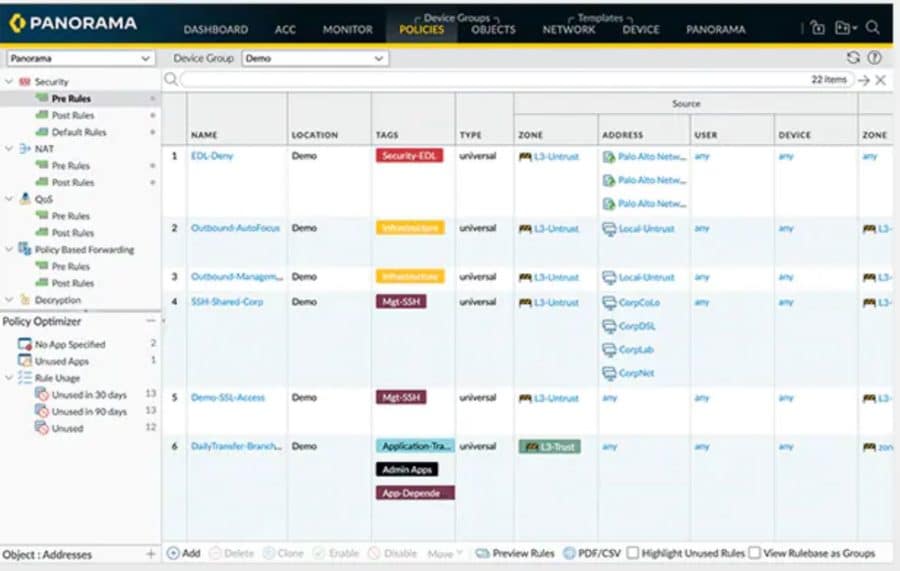Fortinet and Palo Alto Networks are two of the top cybersecurity companies and compete in a number of security markets, among them EDR and firewalls. Security buyers in the market for next-generation firewalls (NGFWs) often compare the two, and with good reason, as both made our list of the top NGFWs and boast strong, independently verified security.
Fortinet and Palo Alto are both leaders in Gartner’s recent network firewall Magic Quadrant — the only other leader is Check Point — and firewalls from both have scored high in independent testing from Cyber Ratings. Fortinet and Palo Alto also receive some of the highest ratings from users, so buyers of either company’s products can have confidence that they’re getting some of the best security possible.
Nonetheless, there are some differences between the two, and we’ll address those here. Before we get into the details, here’s a high-level analysis of the use cases each vendor serves best:
- Fortinet is particularly good for appliance-based distributed enterprise and branch office needs.
- Palo Alto can serve those markets too, but also has an edge in cloud, container and FWaaS use cases, plus a comprehensive security product portfolio.
- If you’re just looking for a firewall with good security, either will do. They may cost more than other firewall offerings, but good network security pays for itself in the cost savings of avoided breaches.
Fortinet vs Palo Alto NGFWs at a Glance
Here’s how Fortinet and Palo Alto NGFWs compare at a glance:
| Pricing | Neither is cheap, but edge to Fortinet | |
| Ease of Deployment | Both vendors score well | |
| Ease of Use | Edge to Fortinet | |
| Security | Both vendors score well, but edge to Palo Alto | |
| Service and Support | Fortinet | |
| Network Firewall Use Cases | Fortinet’s simpler lineup has the edge for appliance use cases | |
| Best for Small Businesses | Fortinet | |
| Best for Cloud Use Cases | Palo Alto | |
| Breadth of Features | Palo Alto | |
| Overall Capabilities | Palo Alto | |
Best for Pricing: Fortinet
With the caveat that both vendors’ firewalls are priced above the low end of the market, we give the edge to Fortinet, which also offers a clearer pricing structure.
The Palo Alto PA hardwall firewall series starts around $1,000 for the PA-410, while the high-end PA-7000 series firewalls start at around $200,000 (and can cost much more with support and subscriptions). There are many options in between, like the 1400, 3400 and 5400 series, plus the ruggedized PA-220R. Palo Alto also offers virtual, container and cloud firewalls, plus other features like AIOps and SD-WAN.
The FortiGate entry-level/branch F series appliances start at around $600. Midrange/campus devices start at $3,600 for the 100F (and can be found for less). Midrange prices can go a lot higher than that, depending on the model and SKU; CDW sells the 600F with three years of support and threat protection for $46,000. The very high-end 520 Gbps FortiGate 7121F can cost $1 million or more with support and enterprise protection. Fortinet offers virtual firewalls too for hybrid cloud use cases.
Best for Deployment and Ease of Use: Fortinet
In Gartner Peer Insights reviews over the last year, users gave both Fortinet and Palo Alto an impressive 4.7 for Integration & Deployment.
Ease of use has come a long way in recent years, as terms like “easy to use,” “user-friendly” and “intuitive” show up in reviews of both companies’ firewalls.
For use cases requiring central management, however, Fortinet’s management tools have a clear edge over Palo Alto’s tools.
Gartner noted in its December 2022 Magic Quadrant: “Fortinet offers mature on-premises and cloud-based centralized management through FortiManager and FortiCloud, respectively. These offerings have feature parity and support centralized management of the majority of Fortinet’s devices. FortiGate customers like the ease of management and configuration of Fortinet’s firewalls.”
Gartner also noted, “Palo Alto Networks’ cloud-based firewall manager, used for distributed-office and centralized-management use cases, is not on a par with on-premises management. Its cloud-based manager is used primarily for the Prisma Access product line and ‘generation 4’ models of hardware.”

Best for Security: Palo Alto Networks
Both vendors offer very strong security; they are, after all, the top two companies in the overall cybersecurity market in our analysis.
Independent firewall tests are becoming a little dated, but when Cyber Ratings last tested enterprise firewalls two years ago, Palo Alto came out on top. In cloud network firewall tests last year, however, Fortinet came out ahead.
We give Palo Alto the overall edge because of its long history of strong results in MITRE endpoint and MSSP testing, and the impressive breadth and innovation of its offerings.
For network firewall appliances, however, you can’t go wrong with either, and Fortinet’s simpler lineup and pricing may even have the edge there.
Best for Cloud and Complex Use Cases: Palo Alto
Fortinet may be best for organizations looking for appliances for distributed and branch office use cases, but Palo Alto has a clear edge in cloud use cases and the needs of complex enterprises.
The sheer range of Palo Alto’s firewalls is impressive, spanning small offices, campuses and businesses, mid-sized organizations and enterprises, and high performance and harsh environment needs.
Fortinet offers very impressive performance too, but it’s Palo Alto’s cloud lineup that makes it stand out here. While both vendors offer virtual firewalls, Palo Alto has the edge in container and cloud firewalls, and AIOps and SD-WAN support are also standout features.
Not surprisingly, Palo Alto’s customer base is skewed toward the midrange and large enterprises. Fortinet’s customer base is more weighted toward mid-sized and small businesses.

Top Fortinet & Palo Alto Alternatives
Fortinet and Palo Alto Networks firewalls aren’t for everyone, particularly the price-conscious.
For those seeking top performance and for whom price is a secondary consideration, Check Point is a worthy competitor.
A number of NGFW vendors may be able to compete on price, among them Cisco, Juniper, SonicWall, Sophos, and Forcepoint. Here are some other NGFWs to consider.
1 Juniper Networks
Juniper and Huawei share the Most Popular award – their users rave about them. Juniper has been coming on strong in the security market with advanced features like machine learning-based detection. Cloud and zero trust features could use more development, but Juniper networking customers in particular should give the company’s SRX firewalls a serious look, and the company has strong capabilities for just about all enterprise use cases.
See our full list of the Best Next-Generation Firewall (NGFW) Vendors for additional buying guidance.
How We Evaluated Fortinet vs Palo Alto NGFWs
For our analysis, we evaluated firewall features, product breadth, performance and security test data, vendor specs, pricing data from resellers, use cases, user reviews, and overall vendor strength and vision.
Real-world performance can, of course, differ from product and lab specs. And no security product can stop everything, so defense-in-depth and layered detection and response technologies are things every organization needs.
The Bottom Line: Fortinet vs Palo Alto Networks
The differences between Fortinet and Palo Alto are small but still significant. Fortinet gets the edge on pricing, support and centralized management. Palo Alto gets the edge on overall capabilities and the sheer breadth of its offerings.
Palo Alto has consistently posted top scores in independent testing, so we’ll give PAN the edge on security — with the caveat that Fortinet recently came out on top in cloud firewall testing, so users can have confidence in both vendors. Surprisingly, both score well on ease of use, so buyers further down market should consider their entry-level and midrange offerings.
Buyers can’t go wrong with either company. Fortinet is particularly good for appliance-based distributed enterprise and branch office needs. Palo Alto can serve those markets too, but also has an edge in cloud, container and FWaaS use cases, plus a comprehensive security product portfolio.
If you’re just looking for a firewall with good security, either will do. They may cost more than competitive offerings, but good security pays for itself in the cost savings of avoided breaches.
Drew Robb contributed to this report.


